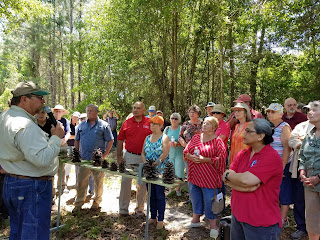Robert Jenkins: 2020 Florida
Land Steward of the Year
 |
Bob Jenkins and his chocolate lab check out
longleaf seedlings on the Jenkins Millview Trace in Escambia County, Florida. Photo by Stan Revis |
The Jenkins family acquired the Millview property during the
Great Depression in the 1930s. By then, the local pine forests had been
timbered out and Millview was a ghost town, a shadow of its former glory. The
family moved to Pensacola in 1956 but continued to grow pine for timber and
turpentine on the Millview property. The land is named the Jenkins Millview
Trace in honor of the last small trace of longleaf pine forest in Millview.
Bob graduated from Escambia High School just down the road
from the family home in Pensacola in 1968. He went on to graduate from Cornell
University in Engineering. He learned his love of the outdoors from years in
the Boy Scouts, ultimately becoming an Eagle Scout. As a scout, he planted pine
trees as a community service project on land controlled by the Pensacola Naval
Air Station where he also learned to shoot skeet and to hunt dove. Bob is now an
active advocate of agricultural and hunting legislation.
In the late 1980s he helped found the first local Quail
Unlimited Chapter with other Pensacola conservationists. Early on, Bob
participated with other Quail Unlimited Chapter members in several community
projects supporting quail habitat in the Blackwater Forest. Through Chapter
activities, he gained knowledge of quail life cycles and the importance of
plants such as lespedeza, wiregrass, broomsedge, and Chickasaw plums for quail.
Most importantly he learned about longleaf pine. The longleaf pine forest had
been the predominant forest type of the Southern Coastal Plain and a habitat
that supported great bobwhite quail hunting.
Jenkins’s father had done a selective timber cut in the late
1960s but the trend at that time was to let slash pine naturally reseed and
regenerate for the pulp and paper industry. During the 1950’s and 60’s the
property was burned to keep lanes open for turpentine collection, but after
that industry shut down, burning stopped and underbrush growth was
unrestrained. When wildfires raged in the late 1990s on the west side of
Escambia County, Bob realized his slash pine stand in Millview was at risk for
a devastating fire due to years of fuel buildup from pine straw and underbrush
overgrowth. Of equal concern were the subdivisions that had been built
surrounding his property and the risk of what a fire on his property would do
to these homes. His land had been become a wildland-urban interface area and he
decided to act.
 |
The start of a goal. Planted longleaf pine seedlings on
the Jenkins Millview Trace in Escambia County, Florida. Photo by Bob Jenkins |
In the early 2000s,
working with his consulting forester, Stan Revis of the Tree Longevity
Corporation, a long-term stewardship plan was devised to harvest the slash pine
and replace them with longleaf pine. Because once established longleaf pine is
adapted to periodic fire, the main goal was to keep the underbrush controlled
by prescribed burns. This would allow the forest to be more open for easy
walking and establishing varied wildlife habitats. This type of management also
greatly reduced the risk of a fire for his neighbors.
Based on the plan, burning
to control the understory was started and the first of over 300,000 longleaf
pines were planted. Purchase of an adjacent property has increased the acreage
of longleaf pine from 375 acres to 600 acres. Most of the forestry work is done
by Bob and Stan Revis and includes long-term planning, site preparation,
establishing fire roads and food plots, herbicide application to control
invasive species such as Chinese tallowtree and cogongrass, beaver control,
prescribed burning, and hiring and directing tree planting crews. The property
has been burned regularly about every three years, but recently, mechanical
mulching has been utilized to remove brush in areas that have not been burned
successfully.
 |
"Why longleaf?" Bob Jenkins explains his family goals and
the benefits of the longleaf pine forest at a landowner tour.
Photo by Cathy Hardin
|
Bob has opened the
property not only to hunting, but also to fellow landowners to participate in tours and prescribed burning training. He has experimented with longleaf planting
techniques and survival rates by alternately planting five rows of
containerized seedlings versus bare-root seedlings on one thirty-acre parcel.
His Stewardship Forest and certification in the American Tree Farm System was
recognized during the 2018 Escambia County Farm tour, organized by the UF/IFAS
Escambia County Cooperative Extension Service.
Although the goal of quail
hunting has yet to be achieved, the forest is home to an abundance of wildlife
including deer, turkey, dove, rabbits, coyotes, raccoons, opossums, and wood
ducks to name a few. Recently a deer hunting club of local families that
include young boys and girls has taken on the job of planting food plots and
enjoying recreational opportunities of the property.
Bob and his wife, Carol,
have been married for 35 years and they have two grown children. The whole
family, including a chocolate Labrador retriever, has helped with planting and
working on the Jenkins Millview Trace.

No comments:
Post a Comment